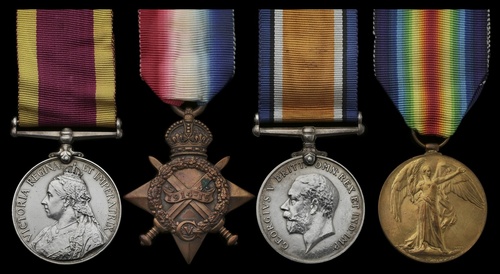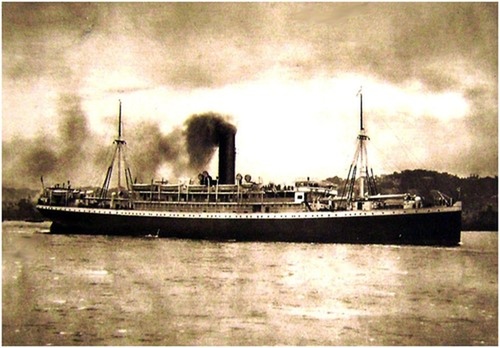Auction: 22003 - Orders, Decorations and Medals
Lot: 371
25 MAY 1917: LOSS OF THE ARMED MERCHANT CRUISER "HILARY"
'The two officers [from H.M.S. Hilary] who were interrogated by the captain of the submarine were the ship's surgeon and one of the Lieutenants. The information given was as evasive as it could be with a pistol held to their heads, but Captain Dean was certain that his confidential books had all gone down in the ship, and that his officers could not have refused the information they gave with the submarine's gun ready to blow all their boats out of the water … '
The Merchant Navy, by Archibald Hurd, refers; the pistol brandishing commander of the enemy submarine was Kapitanleutnant Walther Schwieger.
A Boxer Rebellion and Great War campaign group of four awarded to Lieutenant-Commander T. B. Beckett, Royal Navy
A long-served Gunner R.N. in the armed merchant cruiser H.M.S. Hilary, he was similarly employed at the time of her loss in the North Sea on 25 May 1917, when she struck by three torpedoes from the U-88
The U-boat's commander was Kapitanleutnant Walther Schwieger's, best known for his sinking of the Lusitania in May 1915: dubbed by the British press as 'The Baby Killer', he finally got his comeuppance in September 1917 when the U-88 was sunk with all hands by the Q-ship Stonecrop
Returning to Hilary's own fate in May 1917, an article published in the Nature journal in 1930 is not without interest:
It claimed that Hilary's crew encountered a 'sea monster' off Iceland just three days before their ship's loss. Described as black and smooth with a snake like neck, the 'monster' had an estimated length of 15-30ft.
Seafarer's being suspicious types, it was perhaps an ill-omen, but Hilary's gunners didn't help their cause by engaging it with the ship's 6-pounder guns
China 1900, no clasp (T. B. Beckett, A.B., H.M.S. Dido); 1914-15 Star (Gnr. T. B. Beckett, R.N.); British War and Victory Medal (Gnr. T. B. Beckett, R.N.), very fine (4)
Thomas Barnabus Beckett was born in Bethnal Green, London on 7 May 1881 and entered the Royal Navy as a Boy 2nd Class in April 1897.
Clearly talented - and having witnessed active service off China in H.M.S. Dido - he gained rapid advancement to Petty Officer 1st Class and, in June 1909, he was appointed Gunner, R.N.
A close encounter with 'The Baby Killer'
In November 1914, Beckett joined the ship's company of the armed merchant cruiser H.M.S. Hilary and he was likewise employed at the time of her loss in May 1917.
Captain F. W. Dean, Vice-Admiral commanding the 10th Cruiser Squadron, who was aboard Hilary, takes up the story:
At about 7.22 a.m., the P.V.s [para-vanes] having gone clear, speed was increased again to 12.5 knots, and very shortly after a torpedo struck ship on port side just before boiler room. I went to port side of the bridge and clearly saw remains of its track and the beginning of the same which was between 400 and 500 yards away. I ordered helm hard a port, telegraphed to close W.T. Doors, and then full speed, "action stations" being sounded at the same time. A minute late a report was telephoned from Engine Room that water was up to the furnaces and putting out the fires. I then ordered "abandon ship" stations, standing fast the three after gun's crews.
A report was brought to me that W./T. operator was unable to signal as the aerial was damaged, and he shifted to auxiliary aerial, but dynamo power failing, the emergency batteries were not sufficiently strong to charge it. He then shifted to main aerial again, one wire of which was still in place and the other wire which had been earthing, having now been insulated, he got a spark and sent emergency signal to Gibraltar at 7.45 a.m. He did not however get any acknowledgement till 7.55 a.m. owing to chrystal being out of adjustment through shock.
The second torpedo wrecked instruments entirely. All hands went quickly to their stations, I kept engines going as long as possible to get a little further from submarine. The ship quickly lost her way and at about 8 a.m. I ordered the boats to be lowered. This was done and each boat shoved off as soon as loaded. At about 8.05 a.m., No. 3 boat Port being then alongside getting her last few men in, a second torpedo struck ship port side, nearly under this boat which was blown high in air and its passengers scattered. The four men whose names I have already reported were killed and three were injured, but these and the rest of men from this boat were taken into other boats.
Meanwhile a few shots were fired at periscope but without effect. I now ordered the after-gun's crews to abandon ship and this was done. The S.M.O. Dr. Carr, having had the sick placed in boats, examined the two men who were thrown from No. 3 boat onto the boat deck and found them to be dead. At about 8.30 a.m. the officers and men, about 12 in number, who had remained on board working, left the ship on Carley rafts or boats. Lieutenant-Commander Wray and Asst. Steward Edwards were now the only two persons left on board with me. We provided ourselves with lance bombs on the boat deck in case submarine gave us a chance to use them, also with rifles and ammunition. The periscope was observed from time to time cruising around the ship, and Lieutenant-Commander Wray fired several shots from a 6-pounder at it but without effect. A favourable opportunity offering, we manned a 6-inch gun but found that the training gear had gone wrong through shock and though we pushed the gun round we were unable to align the sights on the moving periscope.
At about 8.40 a third torpedo was fired which struck ship on starboard side of boiler room. At about 9.12 it was apparent that ship was going quickly, so we then went down to the promenade deck and the water having risen to this level, we got in and swam some 20 yards clear when at 9.15, the ship sank. Lieutenant Harris in a somewhat overloaded boat, having picked up many of those from torpedoed boat, had kept close by the ship, and after she sank he closed two boats (which had been stowed inboard and floated clear) and by my order he distributed some men into each of these. One went to take the men from Carley floats, and the other took Lieutenant-Commander Wray, Steward Edwards and myself on board.
The submarine came to surface soon after ship sank and hunted amongst the wreckage picking up objects, she then went to the Carley floats in succession and obtained from officers in them particulars of ship's name, tonnage and armament. She then went off towards SW. The boats made their way towards Shetland under oars and sail, and between 3 and 5 p.m. six of them were rescued by Lieutenant Rivers, R.N.R., in the drifter Maggie Bruce, and in the early morning of the 26th, the seventh and last boat was rescued by the torpedo boat Sarpedon.
I have satisfaction in reporting that the conduct of officers and men was in accordance with tradition.
I do not think anything was left undone which might have saved ship. The submarine was favoured to the utmost extent by bright low sun which partly accounts for periscope not being seen. The alteration of course at 7.10 a.m. enabled submarine to get in perfect position. I attach a list of officers and men whose conduct is considered worthy of special mention.'
Subsequent career
Following Hilary's loss, and having undertaken a navigator's course, Beckett was appointed to the command of the torpedo boat destroyer 83, in which capacity he remained actively employed from June 1917 until January 1919. Having then been promoted to Lieutenant in August 1926, he was placed on the Retired List in May 1931.
Advanced to Lieutenant-Commander on the Retired List in August 1934, Beckett was recalled on the outbreak of hostilities and, among other appointments, served in President III as additional for Defensively Equipped Merchant Ships (D.E.M.S.). He finally hung up his seaboots in March 1947, well into his sixties, a closing report on his service record noting that he had 'the energy of a man twenty years younger than himself.'
Postscript: a convincing 'sea monster'
The creature was seen by Captain Dean and several of the officers and men of H.M.S. Hilary and the encounter is reported as follows:
'About 9 a.m., on approx. 22/5/17, H.M.S. Hilary was some 70 miles S.E. of the S.E. part of Iceland, the day very fine and clear, the Iceland mountains in sight, flat, calm, and smooth sea. An object was observed on the starboard quarter. The ship was turned round and steered straight for the object. When we were about a cable (200 yards) from it the creature quietly moved out of our way, and we passed it on our starboard side at a distance of about 30 yards, getting a very good view of it … As we passed close to the creature it lifted its head once or twice, as if looking at us. The head was in appearance black and glossy, with no protrusions such as ears, etc.; in shape, about that of a cow … the top edge of the neck was just awash, and it curved to almost a semicircle as the creature moved its head as if to follow us with its eyes. The dorsal fin was a black equilateral triangle, which rose at times till the peak was estimated to be four feet above the water.'
The Nature writer adds that 'three independent estimates made on board the Hilary gave a length of the neck of the 'sea serpent' (head to dorsal fin) as 15 feet or more, 20 feet and 28 feet. The head appeared to have a patch of whitish flesh in front, like that around a cow's nostrils. The dorsal fin was thin and flexible, occasionally curving over at the top.'
The Hilary being on patrol at the time, the unfortunate creature was used as a target for anti-submarine practice with the 6-pounders, at about 1200 yards range. A direct hit having apparently scored, it disappeared, no trace remaining.
The creature seems to have borne a most striking resemblance to that seen off the Brazilian coast, in December 1905, from the Earl of Crawford's yacht Valhalla. This also exhibited a dorsal fin rising some four feet out of the water, and a long, snake-like neck, terminating in a head described as resembling that of a turtle.
'In both cases,' concluded the Nature writer, 'there seems no doubt that the observers saw a single living sea-creature of unknown species.'
The crew of the German submarine UB-85 would have agreed, their commander surrendering to the British after what he described as a terrifying encounter with a another 'sea monster' in the same area about a year later. But that's another story.
Subject to 20% VAT on Buyer’s Premium. For more information please view Terms and Conditions for Buyers.
Sold for
£350
Starting price
£300







